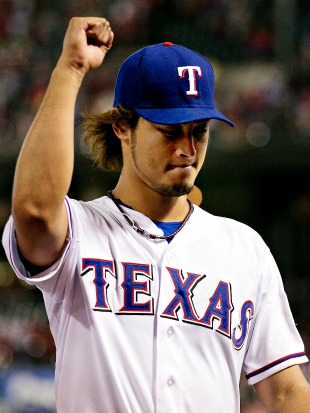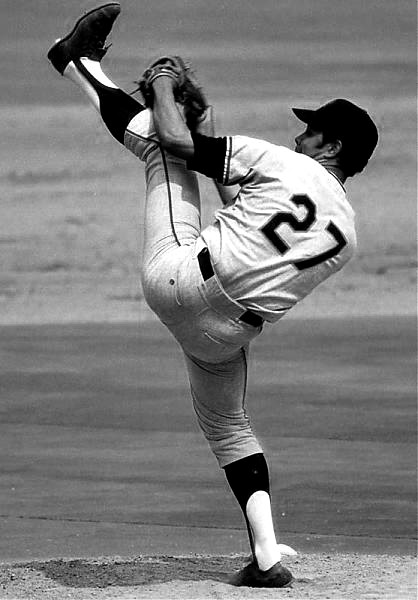In case you weren't paying attention, the Yankees had been firing on all cylinders for most of the last two months. Since the season's nadir on May 21st, when they lost badly (6-0) to the lowly Kansas City Royals and stood 5.5 games behind the Orioles (!) at 21-21, the Yankees had won nearly three out of every four games (36-13) coming into this four game series in the Oakland Mausoleum. They had scored 5.3 runs per game in that span, owing largely to having hit 85 of their MLB-leading 150 home runs in those 49 games. And the injured Brett Gardner never even took a swing in pinstripes.
The team ERA was a sparkling 3.31 during that stretch, with Hiroki Kuroda and Ivan Nova picking up half a dozen Wins each and Phil Hughes and CC Sabathia (despite a 2-week stint on the DL) adding five more apiece. All of that too, without Mariano Rivera, without Joba Chamberlain, and much of it without Andy Pettitte, who's been on the DL with a cracked fibula for most of the last month.
In that time, the Yankees had swept three game sets against the Indians, Blue Jays, Mets, Braves, Nationals and yes, even the Athletics, had taken three out of four from the Red Sox in Boston, and had lost more than two consecutive contests only once. They could do nearly no wrong.
Of course, none of that mattered once they got to Oakland.
They started the long series on Thursday night with Freddy Garcia, who had been stellar since giving up two runs in mop-up duty in that May 21st loss to the Royals. Since then, he was 4-0 with a 2.52 ERA, including wins against Boston and the LAnahfornia Angels in his previous two starts.
No matter. Garcia surrendered nine hits, two walks and four runs, including a homer to Yoenis Cespedes (who maybe isn't such a waste of money after all) and left without finishing the sixth inning. The Yankees could do little except slap a few singles off someone named A.J. Griffin, who allowed only two runs in six innings for his second major league win. I'm beginning to think the Yankees should just steer clear of pitchers named "A.J." all together.
Fortunately, rookie David Phelps showed some mettle by pitching 2.1 perfect innings of relief to keep them in the game. Unfortunately the Yankees managed to get only one man on base the rest of the game - and that only briefly - as Nick Swisher hit a round tripper in the ninth to bring the Bombers within one, where the score would remain.
Friday's game was more tense and dramatic, but the net result was the same. The Yankees had been 38-9 when they hit two or more homers in a game in 2012. In this case, however, the two bombs were both solo shots, one by Robinson Cano and the other by Russell Martin, who's hitting just .180 despite the double digit jacks (Rob Deer, eat your heart out).
More important, perhaps, was that for the second game in a row, the Yankees did not draw a walk. That marked only the 6th time all year in which the Yanks didn't get a single free pass, and the only time it's happened on consecutive days.
The Yankees' other six hits were all singles, and never more than two happened in the same inning. Still, after Martin hit that homer in the top of the 8th inning they were down only one run, thanks to another solid showing from Ivan Nova (6.2 IP, 2 ER). David Robertson did a little Houdini act, escaping the bottom of the inning without allowing any runs, despite a triple and a walk.
Then Robby led off the ninth with a solo homer to tie the game at 2-2, and things were looking up, but the Yankee Retread Corps (Raul Ibanez, Andruw Jones and Eric Chavez) could not muster another hit, so Joe Girardi was forced to bring in his closer, Rafael Soriano, to try to maintain the tie and hope the Yankees could score in the tenth.
No, wait, Girardi brought in lefty Clay Rapada. Well, with the A's only major lefty power threat coming up in Josh Reddick, I guess that made sense. Rapada had been pretty terrible with four different teams before the Yankees signed him in the offseason and essentially decided not to let him face right handed pitching anymore (he had allowed a .359 batting average to righties in the majors before coming to New York), and he's generally been just what they wanted this year. True to LOOGy form, he struck out Reddick on five pitches and then went to take a shower, another
That allowed Girardi to bring in Soriano to hold off the A's and maintain the- no, wait, Girardi instead brought in Cody Eppley, who admittedly has been pretty good this year as well, but who promptly allowed three straight singles to lose the game, 3-2. Joe was apparently saving his closer for a Save situation that never happened, which is a crappy way to lose a game.
Saturday's game was much better, as Phil Hughes gave up only two runs in nearly eight innings - his 7th Quality Start in his last nine outings - and, wait, he took the loss anyway? Hughes allowed only two walks and four hits, but two of those hits were home runs - another by the definitely-not-a-waste-of-$36 million Yoenis Cespedes and one by Brandon Inge, whose 1-for-3 showing brought him right up to the Mendoza Line for the year (eat your heart out, Russell Martin).
The Yankee bats remained uncharacteristically silent once again, as they could do little more than slap singles, and not even many of those. A leadoff singly by Derek Jeter in the first went for naught, as did base knocks by Teixeira and Chavez in the third. Singles by Alex Rodriguez and Raul Ibanez - sandwiched around two groundouts - brought the Yankees' only run home in the 4th.
Curtis Granderson did show a little patience and draw a walk to lead off the 6th - the Yankees' first base on balls since the 4th inning against the Blue Jays on Wednesday - but A-Rod, Cano and Tex all failed to bring him home.
The Yankees would not get another hit until the top of the ninth, when Rodriguez singled off someone named Sean Doolittle, who did a lot by striking out Cano, Teixeira and Andruw Jones to end the game and pick up his first career Save. He threw only two pitches that were not fastballs among his 21 offerings, but since the rest were 93-95 mph heaters from the port side, he evidently didn't feel much need for another pitch.
On Sunday, the Yankee bats finally showed a little life, this against their former teammate Bartolo Colon, as they smacked eight hits (including their only non-homer extra base hit of the four game set, when A-Rod hit a 2-run double off Colon in the third) and scored four runs in six innings and change. But the A's bullpen stymied the Yanks, allowing five baserunners in the next five-plus innings, but none of them past second base.
Soriano finally saw his first action of the series, this time to protect a one-run lead in the ninth. Having not pitched since Tuesday, he may have been a little rusty but even if not, he still blew the Save. Seth Smith smacked a hanging slider over the center field fence to tie the game at 4-4, and the two bullpens exchanged zeros for a few innings until the A's again had the pleasure of facing Cody Eppley with the game on the line in the 12th. A single, a bunt to advance the runner and then Coco hit one crisply to right field to bring home the winning run and give the A's the sweep.
As heartbreaking as it is to get swept like this, especially to lose three of the four games in the 8th inning or later, it's not as though the Yankees were thoroughly schooled or severely beaten. With a smidgeon of luck, they could have won any or all of those four games. They just didn't.
And none of that is to say that the A's don't deserve credit for their wins or that the Yankees shouldn't be blamed for failing to come through in the clutch, or be patient at the plate, or whatever. But it does mean that the Yankees and their fans shouldn't be deluded into thinking that the team is somehow horribly flawed, that this series uncovered some glaring weaknesses or that the sky is falling down on the Yankees.
Nor does this happy moment for the small market A's and their fans mean that they are in any way something other than also-rans in the American League playoff hunt. Sure, the A's are 51-44, but they're also behind the Angels and the Rangers in their own division, both of which can much more readily afford to fill a gap at the trade deadline if needed than Oakland can.
Additionally, the fact that the A's have 48 of their remaining 67 games against teams with winning records means that the hardest part is yet to come. While they have played well against such teams (33-25 to date) it's unlikely that they'll be able to continue that pace.
Their 16-12 record in one run games is very good, the result of some good luck and good relief pitching, and their 10-5 record in such contests since mid-June has been a big part of why they went from nine games under .500 to seven games over in just five weeks. Additionally, their 7-2 record in extra innings and their major league best 11 walk-off wins are much of the reason for their apparent ability to contend this late into the season. This kind of "skill" rarely propels a team through an entire season.
More likely they'll regress to the mean and start losing a few of these close contests. An "offense" that carries three regulars hitting below the Mendoza line isn't likely to blow out many of its opponents, so they'll come back to the pack. More important, perhaps, is that the A's would have to fight off not just the Angels but also best the Rays, the White Sox, the Orioles and even the Red Sox, who have a much better run differential than the A's despite their relative positions in the standings.
The Orioles, though they have the same record as Oakland at the moment, are only there because of extraordinary luck (they're 19-6 in one-run games, 32-38 otherwise) and are therefore not likely to stay there, all other things being equal. Still, they already have 51 wins in the books, and money is not a problem for the O's. A few astute trades could turn them into the team their record suggests they already are.
The Blue Jays might have had a shot but now without Jose Bautista for a while and missing essentially an entire pitching staff due to injuries, they're bound to fade. That leaves six teams for two playoff spots, and I have a hard time imagining that Boston, LA or Chicago won't go and get what they need to make a push for that other spot, or that Oakland's hot streak will prove to be just that: A Streak.
And streaks always have an end.

















